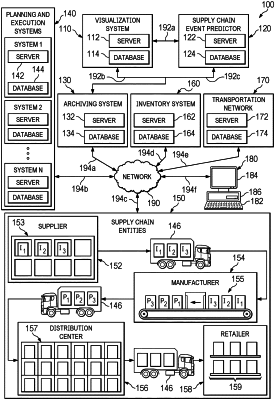| CPC G06Q 10/087 (2013.01) [G06N 20/00 (2019.01); G06Q 10/06313 (2013.01); G06Q 10/0635 (2013.01)] | 20 Claims |

|
1. A system to predict service failures in a supply chain using machine learning, comprising:
a computer comprising a processor and a memory, the computer configured to:
receive historical supply chain data from an archiving system, the archiving system storing historical supply chain data from a supply chain network comprising one or more supply chain entities;
train a prediction model to predict one or more supply chain events using a sample of the historical supply chain data;
predict the one or more supply chain events during a prediction period by applying the trained prediction model, the one or more supply chain events associated with at least one supply chain entity of the one or more supply chain entities;
calculate an occurrence risk score for at least one of the one or more supply chain events, the occurrence risk score indicating a possibility that the at least one of the one or more supply chain events will occur;
calculate precision and recall scores for the prediction model, wherein the precision scores indicate a proportion of predicted supply chain events that actually occur, and wherein the recall scores indicate a proportion of supply chain events that occur will be predicted;
generate one or more alerts for the one or more supply chain events, each of the one or more alerts associated with at least one alert supply chain event of the one or more supply chain events, the one or more alerts comprising at least one alert item;
render, for display on a user interface, a visualization comprising one or more selectable user interface elements represented by one or more alert elements, each of the one or more alert elements associated with an alert; and
provide one or more tools for initiating one or more corrective actions to be undertaken in order to resolve one or more underlying causes of the at least one alert supply chain event.
|